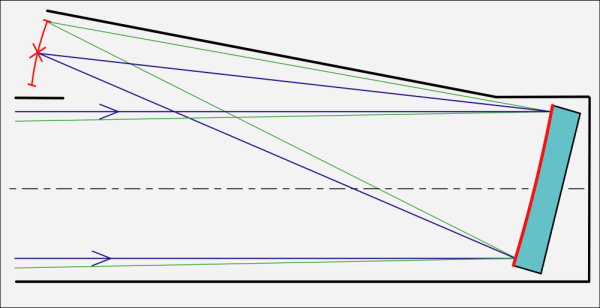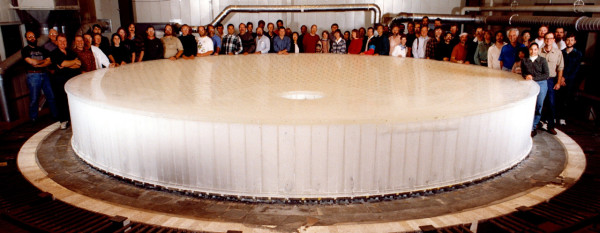"A mouse does not rely on just one hole." -Plautus
When you look at the largest, most powerful optical telescopes in the world, they all have something in common: they all have holes in their central, primary mirrors. This is for a few reasons, including that they're all reflectors, they all need to focus light somewhere in front of the mirror, and they all need to send that light somewhere to be recorded and analyzed.
 Image credit: Wikimedia Commons user Eudjinnius, of a diagram of Herschel-Lomonosov telescope system.
Image credit: Wikimedia Commons user Eudjinnius, of a diagram of Herschel-Lomonosov telescope system.
You can, in principle, focus the light somewhere off-axis, and many amateur telescopes do, but for the professionals, you lose more light that way than you would by simply having a hole in the center. In order to conserve the most light and maximize the image quality with the fewest artifacts, leaving a hole in the mirror is by far the best way to go.
Go read the whole story in no more than 200 words and lots of pictures, on today's Mostly Mute Monday!
- Log in to post comments


When discussing professional telescopes of such large apertures and small focal ratios (f4 to f7), of course your comments are totally valid. For amateurs (backyarders) we do not have the luxury of such projects. The average user would be lucky to have an aperture of 8 inches or so, extending to, maybe 16. For wide field viewing, as in nebulae & extended objects, the wide field approach is preferred (fields of 2 to 3 degrees or so). When it comes to lunar & planetary, we start to look at a narrower FOV. This is where longer focal lengths come into play (f10 to f15). Using offset optics give maximum light gathering for such modest apertures and alleviate any inherrent artefacts from spider & secondary diffraction.
For the professional institutes, I could not imagine a VLT with a focal ratio of 10:1. Phew, blows the mind. :)
Many thanks for the follow up, Ethan.
An excellent article on the Keck telescope. Most of the information is relevant to any reflecting type 'scope.
https://en.wikipedia.org/wiki/W._M._Keck_Observatory
I don't know if the article mentions it somewhere.. not going to Forbes anymore, but title is very misleading. Telescopes DO NOT have holes in the middle. Some telescope designs have holes in the primary mirror , namely Cassegrains and Maskutovs. And it's not about amateur or professional either... there are high end refractors that cost as much as a new car.. no holes.. no mirrors... as we all know.
Hi SL. The original article was 'The Future Of Astronomy: The Giant (25 Meter!) Magellan Telescope (Synopsis)' which looks at the more professional end of the telescope market. Agreed re refractors, however, there is a limit to aperture over mass, ergo the more common practise of mirror manufacture. The Maksutov requires a corrector plate , which limits aperture once again (mass of glass), for the scale of telescopes under discussion. Schmidt cassegrains are also less practical for the use of a corrector plate. With todays technology, one can correct by deformation of the secondary mirror, rather than all that glass out front. Scintillation is corrected for by altering the figure of the secondary, improving the resolution of said 'scope by a factor of ~ 10 for earth based sites.
:)
@PJ
we are on the same page, just was used to more precision in articles here from Ethan. Not a fan of popularist writings. This is a misnomer title, like a title.."why do cars have roll-cages" would be. SOME cars have roll-cages, like some telescopes have holes in them. And as you correctly pointed out.. state sponsored telescopes due to design and manufacturing and etc... have a design like above.
Like you correctly pointed again, many if not all who read this.. if they ever come across a telescope or buy one, will either be a cheaper refractor (no holes) or a dobsonian (again no holes). Even large telescopes (professional ones) like Hale telescope or similar.. are either refractors or dobsonian design.
Yes, modern large telescopes use a modern approach and have hole to focus the beam behind primary mirror. Like I said, we know what was meant... but those who know don't really need the article.. it's the ones that are new to astronomy and who could draw wrong conclusions that most if not all telescopes have a hole in the primary mirror and that it's only amateurs who do it otherwise... which is not correct.
Perhaps it is fortunate we have this medium to highlight such valid points. By discussion we can embrace and include those who are learning as well.